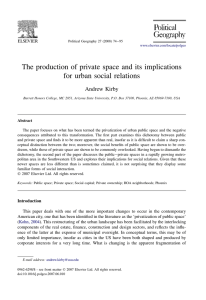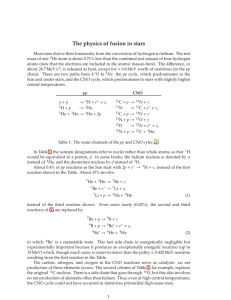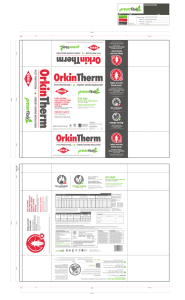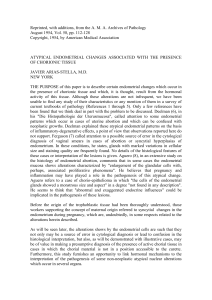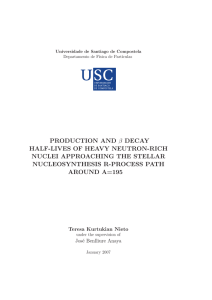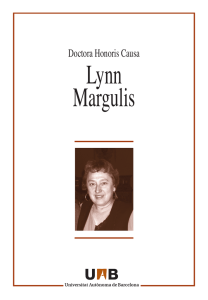Budding and Asymmetric Reproduction of a Trichomonad with as
Anuncio
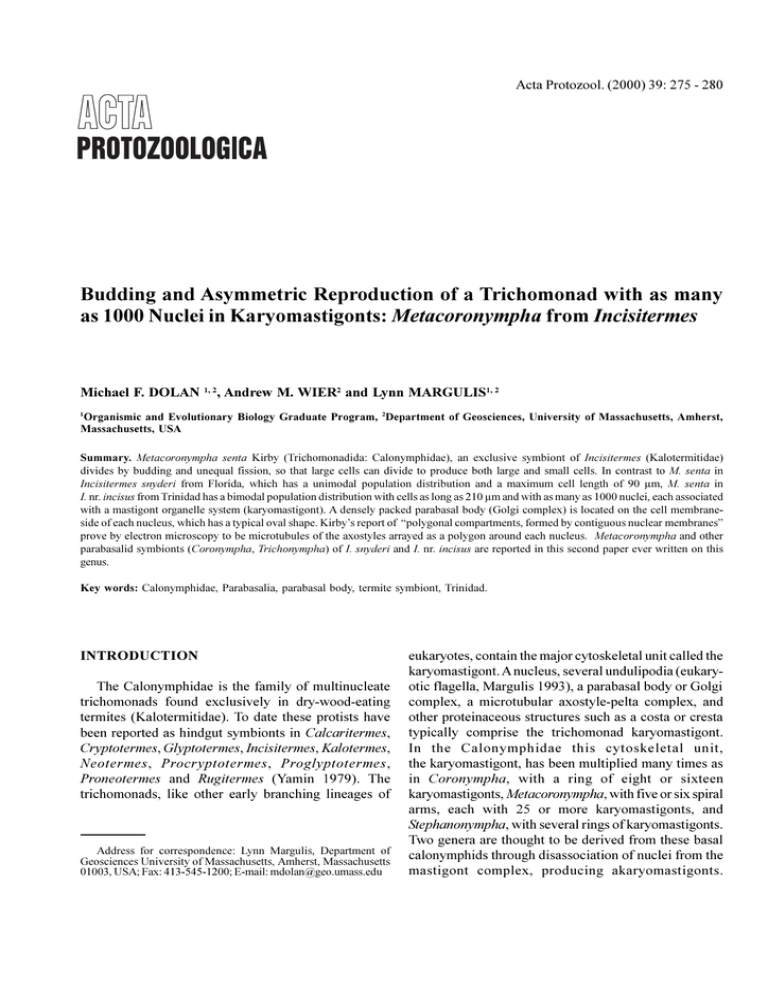
Acta Protozool. (2000) 39: 275 - 280 Budding and Asymmetric Reproduction of a Trichomonad with as many as 1000 Nuclei in Karyomastigonts: Metacoronympha from Incisitermes Michael F. DOLAN 1, 2, Andrew M. WIER2 and Lynn MARGULIS1, 2 Organismic and Evolutionary Biology Graduate Program, 2Department of Geosciences, University of Massachusetts, Amherst, Massachusetts, USA 1 Summary. Metacoronympha senta Kirby (Trichomonadida: Calonymphidae), an exclusive symbiont of Incisitermes (Kalotermitidae) divides by budding and unequal fission, so that large cells can divide to produce both large and small cells. In contrast to M. senta in Incisitermes snyderi from Florida, which has a unimodal population distribution and a maximum cell length of 90 µm, M. senta in I. nr. incisus from Trinidad has a bimodal population distribution with cells as long as 210 µm and with as many as 1000 nuclei, each associated with a mastigont organelle system (karyomastigont). A densely packed parabasal body (Golgi complex) is located on the cell membraneside of each nucleus, which has a typical oval shape. Kirbys report of polygonal compartments, formed by contiguous nuclear membranes prove by electron microscopy to be microtubules of the axostyles arrayed as a polygon around each nucleus. Metacoronympha and other parabasalid symbionts (Coronympha, Trichonympha) of I. snyderi and I. nr. incisus are reported in this second paper ever written on this genus. Key words: Calonymphidae, Parabasalia, parabasal body, termite symbiont, Trinidad. INTRODUCTION The Calonymphidae is the family of multinucleate trichomonads found exclusively in dry-wood-eating termites (Kalotermitidae). To date these protists have been reported as hindgut symbionts in Calcaritermes, Cryptotermes, Glyptotermes, Incisitermes, Kalotermes, Neotermes, Procryptotermes, Proglyptotermes, Proneotermes and Rugitermes (Yamin 1979). The trichomonads, like other early branching lineages of Address for correspondence: Lynn Margulis, Department of Geosciences University of Massachusetts, Amherst, Massachusetts 01003, USA; Fax: 413-545-1200; E-mail: [email protected] eukaryotes, contain the major cytoskeletal unit called the karyomastigont. A nucleus, several undulipodia (eukaryotic flagella, Margulis 1993), a parabasal body or Golgi complex, a microtubular axostyle-pelta complex, and other proteinaceous structures such as a costa or cresta typically comprise the trichomonad karyomastigont. In the Calonymphidae this cytoskeletal unit, the karyomastigont, has been multiplied many times as in Coronympha, with a ring of eight or sixteen karyomastigonts, Metacoronympha, with five or six spiral arms, each with 25 or more karyomastigonts, and Stephanonympha, with several rings of karyomastigonts. Two genera are thought to be derived from these basal calonymphids through disassociation of nuclei from the mastigont complex, producing akaryomastigonts. 276 M. F. Dolan et al. Calonympha has numerous anterior akaryomastigonts and several, more posterior rings of karyomastigonts. In Snyderella all nuclei are detached from mastigonts and are suspended in the cytoplasm while the surface of the cell is covered with hundreds of akaryomastigonts (Kirby 1929, Dolan 1999). The evolution of this family apparently occurred by Kirbys mastigont multiplicity (Kirby and Margulis 1994). Two processes are involved: karyokinesis without cytokinesis which generated the multinucleated state, and replication of the mastigonts without cytokinesis and/or karyokinesis that generated the multimastigont (karyomastigonts and/or akaryomastigonts) state. In describing three genera and numerous species of calonymphids Kirby (1929, 1939; Kirby and Margulis 1994) recorded minute details of karyokinesis, and karyomastigont reproduction, but had little to say about cytokinesis. He confirmed for Coronympha and Metacoronympha (1939), as first observed by Janicki (1915) for Stephanonympha silvestrii and Calonympha grassii, that cells lose their polarity and become spherical, that the nuclei as karyomastigonts distribute randomly at the cell surface. Karyokinesis then occurs simultaneously in all nuclei. The same process was recently reported in Snyderella (Dolan et al. 2000). Because dividing cells of these termite gut symbionts are rare, the pattern of cell division, if any, has not been reported. We have examined two species of Incisitermes for population distribution and cell division patterns of Metacoronympha senta. We report for the first time the symbionts found in these two termites, and make additional observations to clarify Kirbys description of M. senta. MATERIALS AND METHODS The termites examined here were collected from the roots and stumps of red mangrove (Rhizophora mangle L.) Caroni Swamp, Trinidad in the summer 1997. They were identified as Incisitermes nr. incisus based on morphology by Dr. Rudolf Scheffrahn of the University of Floridas Fort Lauderdale Education Center. An authoritative description of this species has not yet been published in part because the termites of the Caribbean have not been fully described. Specimens of Incisitermes snyderi (Light) from central Florida (Lake Placid) and their gut contents were examined for comparison with the Trinidad termite. Five pseudergates from a single colony of each species were removed from their native wood and sacrificed. Their hindgut contents were broken open in 0.6% NaCl. The protists were fixed for 15 min in 1% glutaraldehyde in phosphate buffered saline (PBS), washed with PBS and stained for 30 min with 2 µM of the DNA stains DAPI or SYTOX (Molecular Probes, Eugene, OR), which stain DNA, or 1 µM DIOC7, which stains membranes (Liu et al. 1987). Wet mounts were prepared, sealed with Vaseline and examined within one day of preparation. The cells were measured under a phase contrast microscope with an ocular micrometer and examined using epifluorescence microscopy. Smears were prepared on poly-L-lysine-coated coverslips, fixed in 1% glutaraldehyde, and stained with Heidenhains hematoxylin (Conn and Darrow 1946). To sample the population, the hindgut contents from two pseudergates of each species were fixed separately as above, centrifuged at 9 g for two min, washed once with PBS and allowed to settle to the bottom of the tube. Wet mounts, each containing the gut contents of a termite, were scanned under 9 x g magnification. The length and width of 120 cells from each of two termites from each species were measured using an eyepiece micrometer. Hindgut contents were removed and fixed in glutaraldehyde (2.5% for 48 h at room temperature) in cacodylate buffer pH 7.2. Specimens were post fixed in 1% OsO4 for 1 h and washed 15 min twice in cacodylate buffer. Dehydration in an alcohol series (50%, 70%, 80%, 90%, 95%, 100% three times, 15 min) and immersion three times in propylene oxide followed. The specimen was left over night to embed in a mix of 1:1 propylene oxide and Heplers Epon-Araldite in a 60oC oven, mounted and sectioned with a glass knife using an Ultracut ultramicrotome. Sections collected on 200 mesh hex copper grids, were stained in uranyl acetate (5 min), lead citrate (5 min) and viewed with a JEM-100s electron microscope at 80 kV. RESULTS Incisitermes nr. incisus from Trinidad harbors Metacoronympha senta, Coronympha octonaria, Trichonympha chattoni and a small unidentified monocercomonad. M. senta and C. octonaria but no Trichonympha were in I. snyderi from central Florida. M. senta interphase cells contain five or six spiralling arms of karyomastigonts. The karyomastigont of M. senta bears a 3 µm diameter nucleus, and a small rod-shaped parabasal body 2 µm long located at the cellperiphery side of the nucleus. The axostyles are not fused into a central axostyle bundle. Preparations stained with DIOC7 revealed typical, oval nuclear membranes (Fig. 1A). No polygonal array of membranes pressed against each other from adjacent karyomastigont nuclei were seen as described by Kirby (1939). However, hematoxylin staining revealed polygons as Kirby reported (not shown). The polygonal array surrounding each nucleus is made of axostylar microtubules as revealed by electron microscopy (Fig. 1B). Five of the dozens to hundreds of ovoid to pyriform nuclei are seen surrounded by their microtubule arrays and their peripherally oriented parabasal bodies in Budding reproduction of Metacoronympha 277 Fig. 2. Metacoronympha senta undergoing unequal cell division. A - phase contrast, B - SYTOX stain. Arrow indicates nucleus not incorporated into spiral arms. Scale bar - 5 µm Fig. 1. Metacoronympha senta from Incisitermes snyderi. A - the spherical to oval nuclear envelopes and parabasal bodies (arrow) are apparent. DIOC 7 - stained for epifluorescence microscopy to highlight lipid-rich structures. Scale bar - 10 µm. B - nuclei of M. senta from I. snyderi. Nuclei (n) are spherical to pyriform. Each is associated with a parabasal body (pb) and its parabasal filament (arrowhead) on its side toward the cell periphery. The axostylar microtubules (arrows) are adjacent to the nuclei in a distinct pattern. Spherical structures that may be hydrogenosomes (h) are associated with each karyomastigont. Endocytic bacteria (b) are also seen. C - nucleus with smoothly distributed chromatin, parabasal filament (arrow) underlying stacked Golgi cisternae (parabasal body) at higher magnification. Transmission electron micrographs scale bars - 2 µm 278 M. F. Dolan et al. Fig. 3. Metacoronympha senta budding. A - budding cell, B - another budding cell after karyokinesis, C - same cell as B, SYTOX stain. Scale bar - 5 µm Fig. 4. Metacoronympha senta population distribution by cell length in Incisitermes snyderi (black columns) and Incisitermes nr. incisus (white columns). N = 240 cells of each termite species combined from the hindguts of two termites Fig. 1B. A parabasal filament runs laterally along the nucleus. At regular intervals lateral to the parabasal bodies are several spherical, unwalled bodies that may or may not be membrane bounded. By extrapolation of similar sized and shaped structures in other parabasalids they may be hydrogenosomes. Endobiotic bacteria with walls are also noted in the cytoplasm of Metacoronympha (b in Fig. 1B). In none of the karyomastigont nuclei does the chromatin appear clumped and all display the parabasal filament between the Golgi and distal surface of each nucleus (Fig. 1C). Metacoronympha senta displays two patterns of division. Prior to cytokinesis, cells reorganize such that one offspring cell may have a hundred nuclei while the other has only 20-30 (Figs. 2A, B). Two spiral arrays of nuclei form with one containing the majority of the cells karyomastigonts and the other containing much fewer (Fig. 2B). Additional fluorescent structures are nuclei (arrow) that have not yet been incorporated into a spiral array. This cell is interpreted to have completed karyokinesis, and to have organized its spiral arrays prior to cytokinesis. It is inferred that it will divide into two cells of unequal size and karyomastigont number. Similarly, portions bud off disorganized cells immediately after karyokinesis, prior to rearrangement of the spiral arrays. These processes generate small offspring cells with many fewer nuclei than the parent (Figs. 3A, B, C). Incisitermes nr. incisus contained a distinct subpopulation of M. senta with huge cells, roughly twice the size of those Kirby (1939) described (Fig. 4). This largersized Metacoronympha subpopulation, cells 118 ± 40 µm long and 114 ± 30 µm wide (n=35), comprised 15 percent of the entire sample of M. senta population from two termites (n=240). They were absent in I. snyderi. The large cells often had several hundred Budding reproduction of Metacoronympha 279 Fig. 5. Large Metacoronympha senta with over 1000 nuclei from Incisitermes nr. incisus. DAPI stain. Scale bar - 20 µm karyomastigonts in excess of those described by Kirby (1939). Ten cells at least contained more than 1000 karyomastigont nuclei (Fig. 5). Huge multinucleate M. senta cells, maximum length of 210 µm, were observed as well in six other I. nr. incisus termites. Although the larger cells were more rounded, besides size and nuclei number, no other differences were noticed between the two subpopulations. DISCUSSION Incisitermes snyderi most resembles I. banksi and I. platycephalus based on hindgut symbionts: all three species harbor the two calonymphids Coronympha octonaria and Metacoronympha senta but lack the hypermastigid Trichonympha (Yamin 1979). While no Incisitermes species has the same symbiont complement as I. nr. incisus (the two calonymphids and Trichonympha chattoni), two species, I. milleri and I. schwarzi, are reported to harbor T. chattoni. Metacoronympha senta from five species of Incisitermes, (I. emersoni, I. lighti, I. pacificus, I. platycephalus, and I. tabogae), was described by Kirby (1939) in the only paper ever written on this genus. The population distribution within different species of the termite was not mentioned. Kirby described M. sentas mean length as 45 µm (range: 22-92 µm) with 150 nuclei per cell (range: 66-345). The huge cells with up to 1000 nuclei apparently he never saw, perhaps because he never examined I. nr. incisus, a Trinidad termite. The budding and unequal cell divisions observed here were not reported in previous accounts of calonymphid cytokinesis. Kirby (Kirby and Margulis 1994) wrote of 280 M. F. Dolan et al. Stephanonympha cytokinesis, the nuclei become organized at opposite ends of the cell, and the cell divides to form two mastigotes. The same was observed by Das and Choudhury (1972). Janicki (1915) reported Calonympha dividing by a longitudinal fission, producing two cells with equal numbers of nuclei and mastigonts. We have observed similar equal division in Snyderella, but have also seen budding in that genus (Dolan et al. 2000). Since few cells in division are seen in termites, and since removal from the termite hindgut disrupts their physiology and soon leads to death, the most frequent pattern of karyo- and cytokinesis remains unclear. Yet from the budding and unequal cell division we infer that a large Metacoronympha may produce small offspring cells. Many nuclei per cell (300-1000) were present in all large cells whereas the small cells studied had relatively fewer (60-100). Apparently the reorganization of mastigonts after karyokinesis is not tightly controlled so that distinct, separate groups of mastigonts can organize independently within the same cytoplasm, like a colony of mastigotes (Kirby 1949). Unmeasured variables in the gut may induce the formation and persistence of the large forms of M. senta (such as properties of the mangrove wood, nitrogen or salt concentrations). Yet one may not attribute the presence of huge M. senta to selection pressure by Trichonympha chattoni because other species of Incisitermes that also harbor Trichonympha lack the large-sized M. senta seen in I. nr. incisus. Metacoronympha senta, like all calonymphids, undergoes synchronous karyokinesis where its karyomastigont reproduces as an integrated unit. Thus large cells of this genus must result from karyokineses followed by delayed cytokinesis. This developmental sequence at the cell level corresponds to the evolutionary scenario thought to have produced the multinucleate, multimastigont Calonymphidae from its monomastigont trichomonad ancestor (Kirby 1949, Margulis et al. 2000). The bimodal population distribution in the size of Metacoronympha senta (Fig. 4) may indicate extant inprogress speciation in these protists. No sexual processes have ever been reported for any of the five Calonymphid genera. The smaller M. senta may be simply a bud cloned from the large form, consistent with the budding pattern seen here (Fig. 3). That, by contrast, it is an incipient new species is testable by comparison of gene sequences (ssrRNA for example), and ultrastructure between cells of the two size classes. Acknowledgments. We thank Mark Deyrup of the Lake Placid (Florida) Biological Station for providing I. snyderi, and Dr. Rudolf Scheffrahn for identifying the Trinidad termite. This work was supported by the University of Massachusetts Graduate School, the Richard Lounsbery Foundation and a NASA Office of Space Sciences Exobiology Program grant to Lynn Margulis. REFERENCES Conn H. J., Darrow M. A. (1946) Staining Procedures. Biotech Publications, Geneva, NY Das A. K., Choudhury A. (1972) Calonymphid flagellates (Trichomonadida: Mastigophora) of Indian termites. Proc. Zool. Soc. Calcutta 25: 25-33 Dolan M. F. (1999) Amitochondriate protists: trichomonad symbionts of dry-wood-eating termites. Dissertation, University of Massachusetts Amherst. Available on microfilm from Bell and Howell Information and Learning, Accession Number 9932306 Dolan M. F., Wier A. M., Margulis L. (2000) Surface kinetosomes and disconnected nuclei of a Calonymphid: ultrastructure and evolutionary significance of Snyderella tabogae. Acta Protozool. 39: 135-141 Janicki C. (1915) Untersuchungen an parasitischen Flagellaten. Zeit. Wiss. Zool. 112: 573-691 Kirby H. (1929) Snyderella and Coronympha, two new genera of multinucleate flagellates from termites. Univ. Calif. Publ. Zool. 31: 417-432 Kirby H. (1939) Two new flagellates from termites in the genera Coronympha Kirby, and Metacoronympha Kirby, new genus. Proc. Calif. Acad. Sci. 22: 207-220 Kirby H. (1949) Systematic differentiation and evolution of flagellates in termites. Rev. Soc. Mex. Hist. Nat. 10: 57-79 Kirby H., Margulis L. (1994) Harold Kirbys symbionts of termites: Karyomastigont reproduction and Calonymphid taxonomy. Symbiosis 16: 7-63 Liu Z., Bushnell W. R., Brambl R. (1987) Pontentiometric cyanine dyes are sensitive probes for mitochondria in intact plant cells. Plant Physiol. 84:1385-1390 Margulis L. (1993) Symbiosis in Cell Evolution. 2 ed. W. H. Freeman, New York Margulis L., Dolan M. F., Guerrero R. (2000) The chimeric eukaryote. Origin of the nucleus from the karyomastigont in amitochondriate protists. Proc. Natl. Acad. Sci. USA 97: 69546959 Yamin M. A. (1979) Flagellates of the orders Trichomonadida Kirby, Oxymonadida Grassé, and Hypermastigida Grassi & Foà reported from lower termites (Isoptera families Mastotermitidae, Kalotermitidae, Hodotermitidae, Termopsidae, Rhinotermitidae and Serritermitidae) and from the wood-feeding roach Cryptocercus (Dictyoptera: Cryptocercidae). Sociobiology 4: 1-120 Received on 19th June, 2000; accepted on 14th August, 2000
